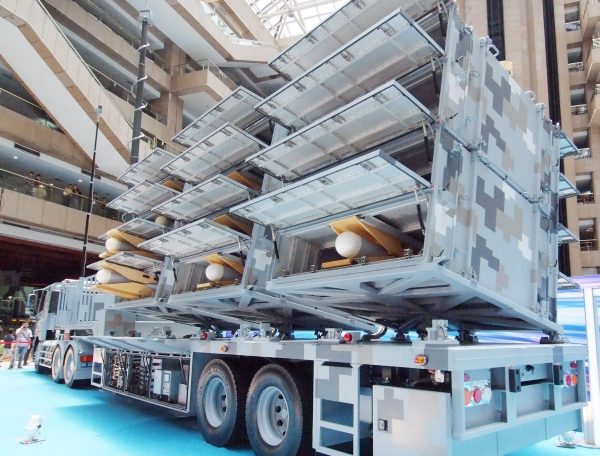Taiwan Displayed Its Lethal Drone Swarm At TADTE 2019
A welcome surprise at the Taipei Aerospace & Defense Technology Exhibition 2019 (TADTE 2019), which shared its floor space with Drone Taiwan 2019, was a single 10×10 semi-trailer carrying the launchers for small autonomous UAVs. Taiwanese media described them as “anti-radiation drones” and their intended purpose was far from secret. News agency Radio Taiwan International even ran a 3D animated clip depicting an aircraft carrier and its escorts being struck by the drones. Elsewhere online, comparisons were immediately made with the IAI Harop or Harpy, the notorious “kamikaze drone” that has earned itself a fearsome reputation.
TADTE 2019 and its partner event Drone Taiwan 2019 were held at their usual venue, the Taipei World Trade Center, from August 15 until 17. The main thrust of the show, rather than just military equipment, is to promote high tech manufacturing and further advance Taiwan’s cutting edge industries. Indeed, one of TADTE 2019’s goals was pushing an “Industry 4.0” or fourth industrial revolution roadmap. But the portion of the show devoted to military stuff delivered beyond expectations. Commanding the largest exhibit was the defense ministry and its creations, foremost being the MALE drone called the Ten Yungin static display.
Behind it was the semi-trailer loaded with 12 Jian Hsiang loitering munitions. Their “anti-radiation” capability means each of them can detect radio signals emanating from a location or vehicle and home on it. This suggests each Jian Hsiang is armed with a missile warhead and if they’re integrated with the ROC Army’s coastal defenses, then another layer of deterrence is added to the Taiwan Strait. The effectiveness of the Jian Hsiang is increased if the ROC Navy adopt them too for their surface vessels. Today’s anti-air defenses on warships are simply not equipped to neutralize drone swarms.
Public information on the Jian Hsiang is extremely limited save for a few images shared by Taiwanese media and the TADTE 2019 organizers. But its appearance isn’t too surprising. Each propeller-driven Jian Hsiang has a cylindrical fuselage married to a delta wing configuration with endplates on the wing edges. Specifications such as altitude, endurance, and speed remain secret but most loitering munitions today are able to perform surveillance if they’re not utilized in offensive roles. The National Chung-Shan Institute of Science and Technology (NCSIST) may have hinted at the Jian Hsiang’s origins in February this year when it released a cryptic news item on its website that claimed an “anti-radiation UAV [is] entirely designed and manufactured by NCSIST.”
Drone swarms are a sinister trend that only flourished this decade. The first widely known battlefield use of a loitering munition was the short and sudden Nagorno-Karabakh war in early 2016 when Azerbaijan used its Israeli-made Harpys on unsuspecting Armenian troops, inflicting a few deaths. During the struggle to retake the Iraqi city of Mosul from ISIS in 2017, the terror group repurposed hobbyist quadcopters and used them for carrying bomblets. The following year, a Russian base in Syria was attacked by an actual swarm of small propeller aircraft each loaded with plastic explosive. The evolution of loitering munitions in small wars has been so rapid that effective countermeasures for destroying them en masse are unavailable, but laser-based defenses and large caliber anti-aircraft guns seem the likeliest choices regular armies can embrace.
With TADTE 2019 over and done with, Taiwan’s eminence as a regional drone power needs to be recognized. At this point its state-owned R&D labs are a few prototypes away from a supersonic UCAV.














Comments are closed.